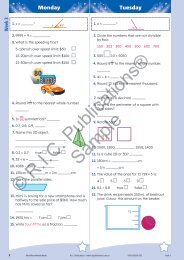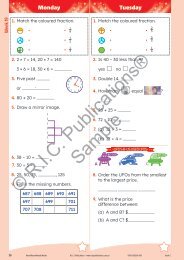Create successful ePaper yourself
Turn your PDF publications into a flip-book with our unique Google optimized e-Paper software.
<strong>Figures</strong> <strong>of</strong> speech<br />
Idioms<br />
Focus<br />
Idioms<br />
Definition<br />
• An idiom is a saying peculiar to a language in which<br />
real <strong>and</strong> literal meanings are different.<br />
Explanation<br />
• Idioms are metaphorical phrases that are not meant<br />
to be taken literally. The true meaning <strong>of</strong> an idiom<br />
can not be found from the meaning <strong>of</strong> its individual<br />
words but is learned through its use in context.<br />
• Idioms are an integral part <strong>of</strong> the English language<br />
<strong>and</strong> an underst<strong>and</strong>ing <strong>of</strong> them is essential for the<br />
comprehension <strong>of</strong> a wide range <strong>of</strong> texts <strong>and</strong> for<br />
interesting writing.<br />
Worksheet information<br />
• Before completing the worksheet, discuss idioms<br />
<strong>and</strong> their role in adding to the richness <strong>of</strong> the English<br />
language. What idioms are the students familiar<br />
with? Do they know the origins <strong>of</strong> any idioms?<br />
Why do they think idioms have survived over<br />
generations? Do they think idioms are a valuable<br />
part <strong>of</strong> the language? Why/Why not?<br />
• Ask students to close their eyes as you read a<br />
sentence containing an idiom. Ask them how they<br />
visualised the idiom. What do they think it means?<br />
How well do they think it conveys its meaning?<br />
• In pairs, students discuss the text <strong>and</strong> identify the<br />
six idioms. They discuss <strong>and</strong> record the idioms <strong>and</strong><br />
their meanings.<br />
• In Question 2, students illustrate <strong>and</strong> label two<br />
idioms which they <strong>of</strong>ten use or hear. Before labelling<br />
the illustrations, they could ask other class members<br />
if they recognise the idioms they represent.<br />
• In Question 3, students research different idioms<br />
before choosing one which appeals to them.<br />
Considering its meaning, students create another<br />
expression with the same meaning.<br />
Ideas for further practice<br />
• Create an illustrated display <strong>of</strong> idioms, their<br />
meanings <strong>and</strong> origins.<br />
• Create an illustrated class book <strong>of</strong> idioms in context.<br />
Answers<br />
1. (a) up to their ears <strong>–</strong> very busy<br />
(b) tail end <strong>–</strong> the last part <strong>of</strong> a job/situation<br />
(c) dead on their feet <strong>–</strong> extremely tired<br />
(d) angel <strong>of</strong> mercy <strong>–</strong> someone who arrives just as<br />
he/she is needed<br />
(e) sleep the sleep <strong>of</strong> the dead <strong>–</strong> sleep soundly<br />
2.<strong>–</strong>3. Teacher check<br />
©R.I.C. Publications<br />
Low Resolution Images<br />
Display Copy<br />
<strong>Primary</strong> grammar <strong>and</strong> word study 80<br />
www.ricpublications.com.au R.I.C. Publications ®


















